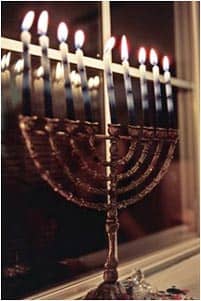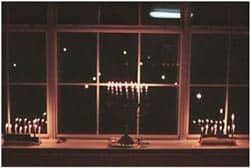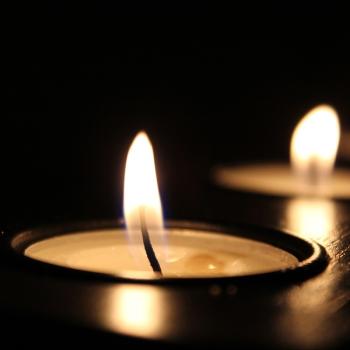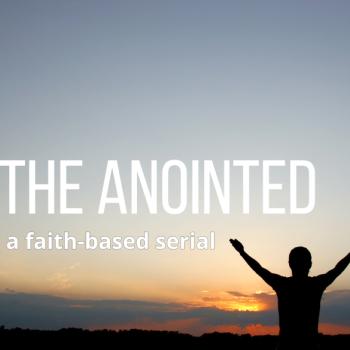By Rabbi Iscah Waldman
 Not every commandment is given a rabbinical justification as clear as that of the mitzvah (commandment) of lighting the Hanukkah lights (whether they are candles or oil, which are both acceptable). The rabbis explain that we light them in order to publicize the miracle of the holiday (pirsumei nisa in Aramaic, the language of the Talmud).
Not every commandment is given a rabbinical justification as clear as that of the mitzvah (commandment) of lighting the Hanukkah lights (whether they are candles or oil, which are both acceptable). The rabbis explain that we light them in order to publicize the miracle of the holiday (pirsumei nisa in Aramaic, the language of the Talmud).
This symbolic act shifted during the time of the rabbis from the lighting of a solitary candle each night of the holiday to the lighting of an increasing number of candles throughout the eight nights of Hanukkah, according to the custom of the House of Hillel. These lights were to be placed outside, in a public space, during the most heavily trafficked time of the evening. Today, the variety of practices range from carefully measured oil lamps to electric menorahs in department store windows to the lighting of 30-foot Hanukkah menorahs in public squares in cities all over the world.
The requirement to kindle lights on Hanukkah could easily be fulfilled with the lighting of a single light. This solitary light was all that was needed to symbolize the miracle of this late holiday -- be it the divine intervention of the story of the oil, or the Maccabean victory. At an early stage, the rabbis delineated a mehadrin (better or more meticulous) way to perform the mitzvah, namely to allow for one candle per family member each day.
The mehadrin min hamehadrin (the most meticulous) method would be to do precisely what has since become the common practice -- to begin with one candle and add a candle for each subsequent night of the holiday. Along with the development of how many lights would suffice to properly publicize the miracle, questions arose surrounding the actual placement of the Hanukkah lights: How can the lights be placed in a way that maximizes their exposure to the public?
Maximum Exposure
Not unlike the idea behind TV networks' "prime time," the rabbis were careful to determine the proper time for lighting the hanukkiyah (Hanukkah lamp, also known as a menorah) as the one during which the largest amount of traffic would be able to view the miracle renewed in every house. During the thirty minutes or so that followed sunset, people made their way back home from the market or workplace, and this would be the optimum time to have passersby walk through what must have seemed like an endless number of kindled lights. The lights were to be lit outside in the courtyard, or if one lived on another floor, in a window so that people could see it.
 Today, it has become common for people to place their Hanukkah lights in the window for the neighbors to see; and one can even find some houses in Israel that have a special niche facing the front, in order to allow people to place their lit hanukkiyot (the plural of hanukkiyah) in a glass-enclosed display cases of their very own.
Today, it has become common for people to place their Hanukkah lights in the window for the neighbors to see; and one can even find some houses in Israel that have a special niche facing the front, in order to allow people to place their lit hanukkiyot (the plural of hanukkiyah) in a glass-enclosed display cases of their very own.
Dangerous Publicity
In a world that was not always tolerant of varying religious practices, the rabbis permitted the lighting of the Hanukkah lights inside on a table, if one felt that one was in a she'at ha-d'khak (a time of danger). This teaches us that, while publicizing the miracle is the central reason of the holiday, publicizing the miracle to one's family is the essence, and further steps need not be taken if one perceives dangerous consequences.
 Interestingly, even in the United States, where religious freedom is touted as one of the proudest achievements, the concept of she'at ha-d'khak has been tested, though not in the traditional manner of taking Hanukkah displays inside during times of danger. One modern example: In Billings, Montana, in 1993, a small boy placed a Hanukkah decoration in his bedroom window, only to have it destroyed when a rock shattered the window. In reaction to what was likely vandalism by members of an Aryan group, a campaign was started to have both Jews and non-Jews (the clear majority in Billings) decorate their windows with a hanukkiyah or with a picture of one. Ten thousand people joined in this campaign, and while several windows were still smashed, this town became quite an inspiration to many who appreciated its courage in the face of religious hatred and intolerance.
Interestingly, even in the United States, where religious freedom is touted as one of the proudest achievements, the concept of she'at ha-d'khak has been tested, though not in the traditional manner of taking Hanukkah displays inside during times of danger. One modern example: In Billings, Montana, in 1993, a small boy placed a Hanukkah decoration in his bedroom window, only to have it destroyed when a rock shattered the window. In reaction to what was likely vandalism by members of an Aryan group, a campaign was started to have both Jews and non-Jews (the clear majority in Billings) decorate their windows with a hanukkiyah or with a picture of one. Ten thousand people joined in this campaign, and while several windows were still smashed, this town became quite an inspiration to many who appreciated its courage in the face of religious hatred and intolerance.




